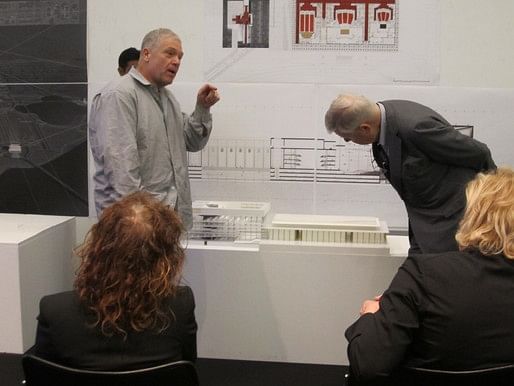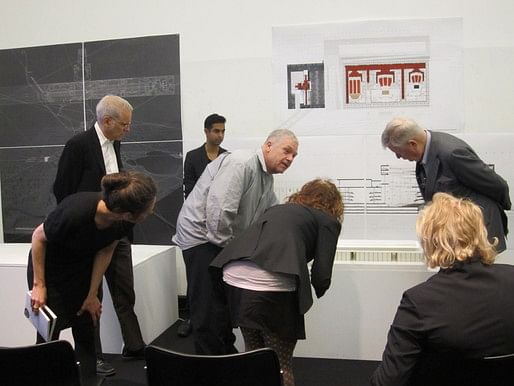
Hi Archinect!
Second day of M.Arch.I thesis reviews at the GSD.
9:30 am: Fareez Giga begins presenting "Nonsense." Advisor: P. Scott Cohen.
"This all began with Lewis Carroll's Alice's Adventures in Wonderland." ...Reality is a construct, a fiction. To confront the real is to...understand this fiction.
The project is based on the Kennedy Center in Washington DC; typically accessed by car. Fareez quotes Ada Louise Huxtable on the building:
The style of the Kennedy Center is Washington superscale, but just a little bit bigger. Albert Speer would have approved . . . What it has in size, it lacks in distinction. Its character is aggrandized posh. It is an embarrassment to have it stand as a symbol of American artistic achievement before the nation and the world. . . . The emperor, unfortunately, is wearing clothes. And the world is looking . . . The building is a national tragedy. It is a cross between a concrete candy box and a marble sarcophagus in which the art of architecture lies buried.
Architecture cannot be rid of its rational requirements but it can choose to interpret them at will.
The program is a parking garage and reconfigurable drive-in theater.
The building's podium aims to shift the experience of the building to the Kennedy Center itself, which becomes even more so embedded in a field of columns. The Kennedy Center becomes a fiction expanded.
The parking exists on the same levels as the seats in the theater, so you can go directly in.
Jeff Kipnis: How do we define the nonsensical in the project? It's philosophically extremely interesting but not--yet--particularly connected to your ambitions.
FG: On the urban scale, the nonsensical effect is that it has multiple associations. The Kennedy Center stands outside the National Mall; now it has a presence on the mall.
Wes Jones: Are we talking about nonsense or no sense?
JK: I want to giggle or laugh or get it--I want to understand what is nonsensical about it.
FG: For one example, the plan is rendered the way it is, the red carpet and the chandeliers [are on one axis while..] You can see people in gowns at the concert but at the same time, you can stay in your car and watch.
Catherine Ingraham: But cars aren't funny.
JK: [They could be.] Do you agree with Ada Louise Huxtable? I think her observations are exactly right, but her judgment is exactly wrong. She's missing the comedy of it. Her quote is about the building in Washington, and about Washington itself, which is slightly overscaled.
It's not fiction versus nonfiction. You have to figure out one kind of fiction and another fiction. But...you stay in the geometric language of the original building.
CI: I don't see how you can escape from the literal...you have to speak in the vernacular language you're making fun of. The unfinished is a tactic; and there are other tactics. At the same time you're still in the vernacular of that which you're attacking.
Ingeborg Rocker: For me the uncanny isn't achieved. There's an alignment but I would also like to see a [... ] of the materiality [at the junction where the intervention begins].


Harry Cobb: This is a very interesting case of a combined work. I have to say it's growing on me. The notion that you could adjoin the Kennedy with something that could make nonsense of it; the nonsense is in the combined work. I don't think there's anything nonsensical about your intervention [on its own]. It would be nice if our culture were mature enough to accept that kind of nonsense in a building. ...But at the top, what is that?
FG: It's a full theater where the parking plate transforms into a stage. These become balcony seats.
...CI: I think the part of that that is interesting is where you allow it to be part of the urban system that it's in.
FG: I was playing with ideas of panorama...the roofplate becomes a panorama, but it's such a crap place--nobody goes up there.
CI: I don't mean to say it "could have been..." But just thinking through your problem. I remember when Herzog and de Meuron began to operate on modernist principles again.
JK: Do agree with Harry, that you wish our culture were sufficiently mature that we could enjoy [nonsense]? Because I do wish that.
HC: The entire project hangs on two things: the columns and their relationship to the multiple slabs; and the transparency. As a thesis project, to launch you into the next stage of your life. It was a big mistake to not develop that column relationship at a higher level of detail...It has a lot of potential that you haven't reached.
WJ: When you say nonsense, we immediately go to the critical. But we could also say, if it's nonsense, let's make it better. Today, that would be [more interesting] than just making fun of it. ..It seems to me sort of casual--serious only to architects who might pay attention to it. All of these problems with the silly columns on the outside could be rendered less silly by a good architect. Harry was saying this is polite.
HC:--kind--
WJ: It would be kinder if you just started over.
HC: Your analogy is not...I don't agree with that. This did create a conversation. ...Though it's implausible to say the least.
IR: A crazy paradox for me is that on one hand you need to make sense of the existing building to make nonsense of it.
CI: But I think Wes' point about nonsense is right. Nonsense pre-exists; to do nonsense on top of nonsense is redundant. But to absorb the nonsense of the fake columns and the entry--then you begin to get a real tension between the nonsensical existing and the constnat grappling.
HI: It doesn't need to be touched..everything can be connected below the platform. It's not yet a conversation until there's an investigation of material and detail at a much higher level--those columns and those slabs.
10:19: The review becomes incomprehensible as the critics continue to argue over this point in reference to various aspects of how the intervention attaches to the existing building.
Rodolphe el-Khoury: You know how young people used to get their drivers license right away when they were 16 and now people don't care--I think we are past the stage of using the car as a critique. We're over the romance with the car.
WJ: And kids don't go to the Kennedy Center, it's all gray-hairs like us.
FG: I would argue that [the car] is still present in DC.
JK: Harry, I need a lesson here, because I'm not an architect. What drawing are you looking for?
HC: What I would want to see is a detail drawing at a scale sufficient to see...structure, material, and detail--because they're very peculiar columns--so how do they meet those slabs?
JK: That's good because now I'll say things like "column-slab relationship..."
PSC wraps things up. "Everyone congratulates you, Fareez."
Thanks for reading!
Lian
This blog was most active from 2009-2013. Writing about my experiences and life at Harvard GSD started out as a way for me to process my experiences as an M.Arch.I student, and evolved into a record of the intellectual and cultural life of the Cambridge architecture (and to a lesser extent, design/technology) community, through live-blogs. These days, I work as a data storyteller (and blogger at Littldata.com) in San Francisco, and still post here once in a while.



2 Comments
this is my fav quote...
JK: That's good because now I'll say things like "column-slab relationship..."
Column slab relationship..so visible yet never thought of taken such attempt...nice dialogue.
Block this user
Are you sure you want to block this user and hide all related comments throughout the site?
Archinect
This is your first comment on Archinect. Your comment will be visible once approved.